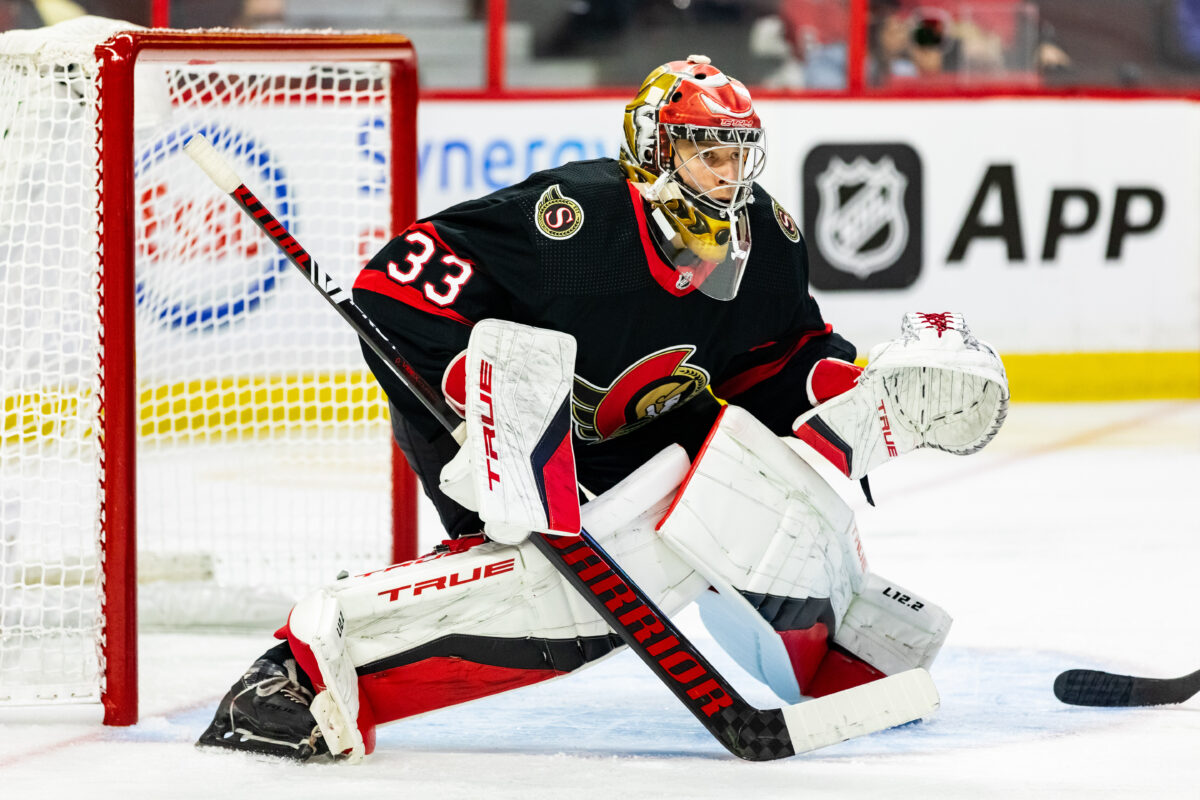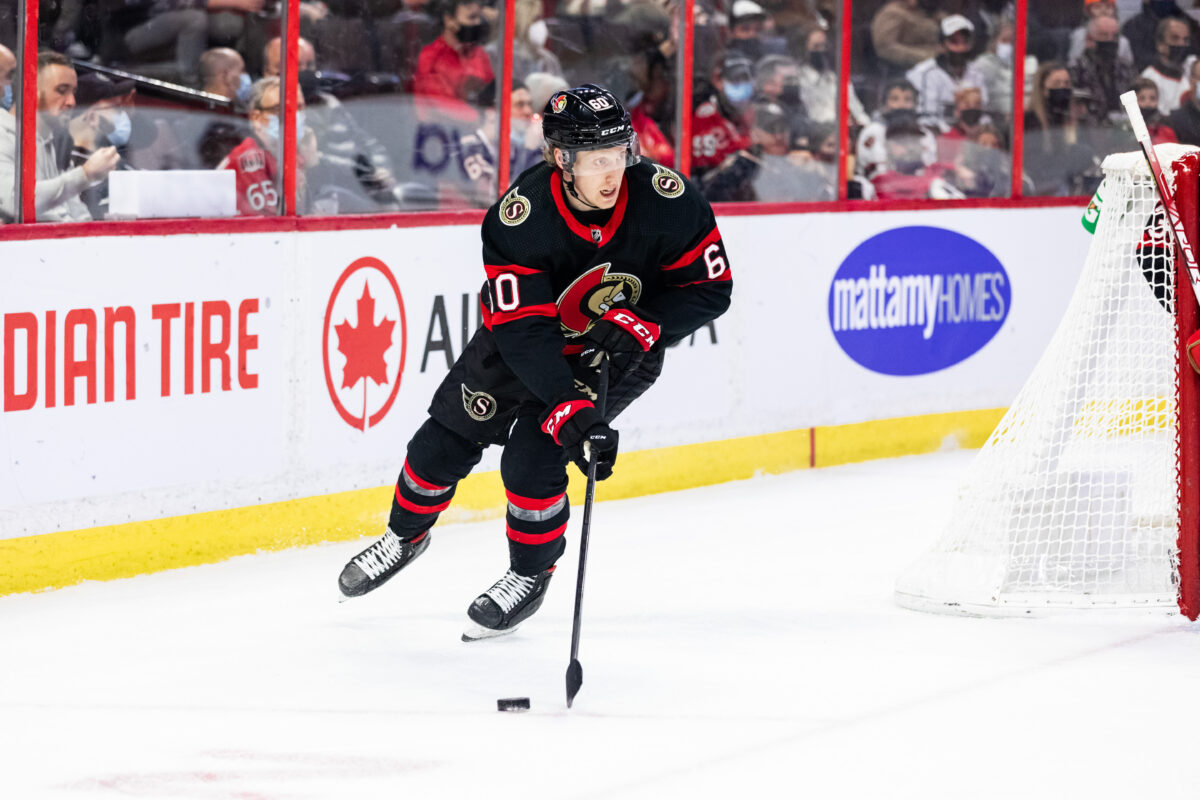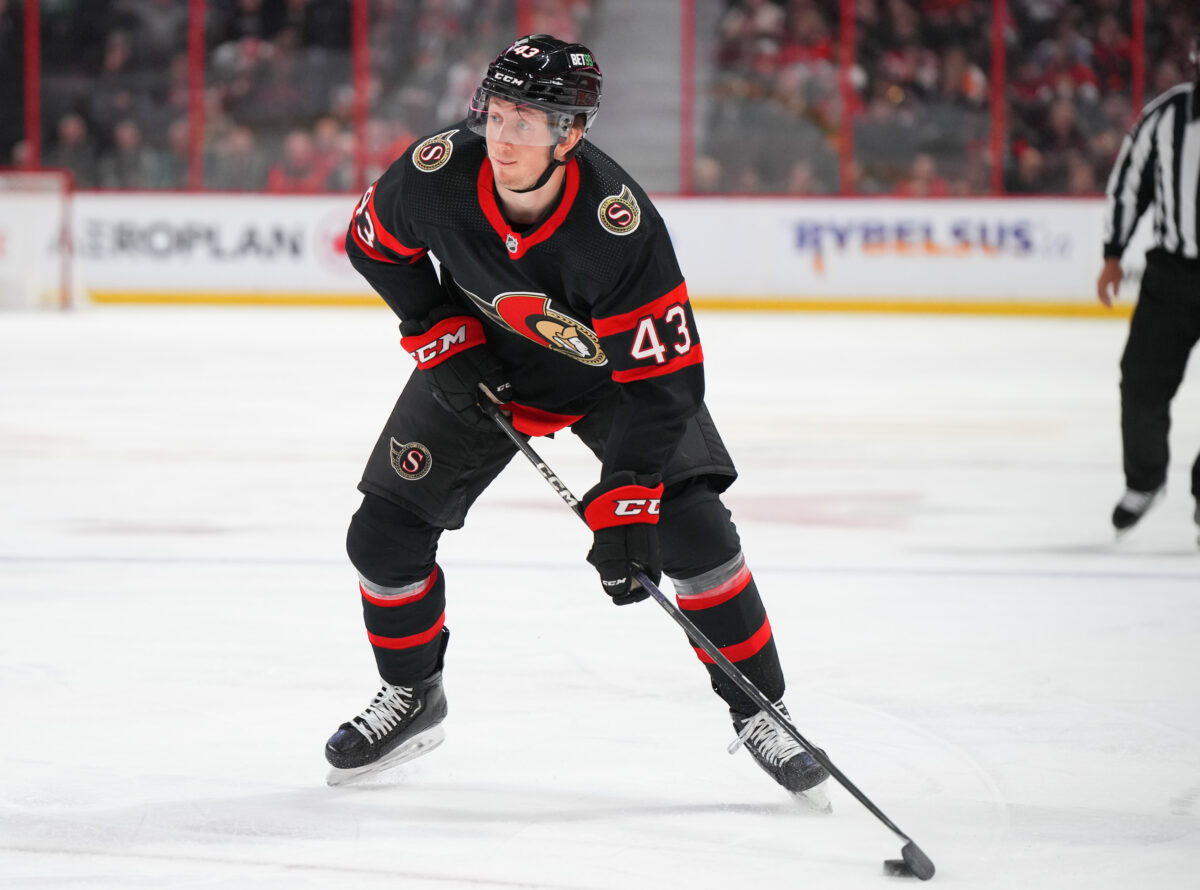The 2022-23 season didn’t go as planned for the Ottawa Senators. The rebuild was supposed to be over, yet a disastrous start to the season killed all hope of making the playoffs that not even a late-season surge could repair. But there is still plenty of hope for this team that is stacked to the brim with young talent on the precipice of breaking franchise records. It’s arguably the best-built team the city has ever seen since it arrived in 1992-93.

However, the one unfortunate side effect to the Senators’ success is that its prospect pool has been thoroughly depleted. No longer can they boast to have one of the best farm systems in the NHL and while some promising players are waiting for their chance in Ottawa, the group overall does not offer a lot of high-end upside. That’s not necessarily a bad thing, of course; competitive teams rarely have a top-tier offence and possess some of the best players outside of the NHL. For the Senators, though, it means that their playoff window now has a time frame.
Of course, a lot can change in a season, so let’s take a look at the prospects currently in the Senators’ system and see where they fit into the team’s future.
What is a Prospect Pyramid?
Created by YouTuber Steve Dangle, the Prospect Pyramid was designed to be a cleaner and less divisive model to rank an organization’s prospects. Instead of trying to split hairs and organize young players into, say, a top-20 list, they are simply put into one of five tiers, which are as follows:
Tier 1 – Elite or top-line, top-pair talent
Tier 2 – Top-six forward, top-four defender, starting goaltender
Tier 3 – Third-line forward, bottom-pair defender, backup goaltender
Tier 4 – Role players, bottom-line forward, depth defenceman or forward
Tier 5 – Minor league player used for call-ups
For this list, I will use the Calder Trophy definition of a prospect, that being a player who is under 26 years old and has not played more than 25 games in a single season or six or more games in each of any two preceding seasons. That means that, for this list, Jacob Bernard-Docker is no longer a prospect as he played 19 games last season and eight games the previous season, even though he hasn’t graduated to the NHL quite yet. That still leaves quite a large group of players, though, so I’ll mention the best examples of each tier as well as any notable newcomers.
Tier 1: Empty
Once again, the Senators are without a Tier 1 prospect, which is in part a byproduct of trading away both their 2022 and 2023 first-round picks. For a team that is pushing for the playoffs, their best players should be in the lineup, not still developing. That’s certainly the case with Tim Stutzle, who is making a case that he is one of the best up-and-coming players in the NHL. I initially wasn’t convinced he was a top point producer, instead looking at Patrice Bergeron as a comparison. Yet, once again, I’ve been too conservative in my estimations. In his third season in the league, he led the team with 39 goals and 90 points, and he may hit 100 points within the next two seasons.
Tier 2: Mads Sogaard
It might seem like top goalie prospect Mads Sogaard had a disappointing season last year. He won eight of his 19 NHL games while posting a .889 save percentage (SV%) and a 3.32 goals-against average (GAA). In the American Hockey League (AHL), he won just six of his 22 games while recording a .893 SV% and a 3.47 GAA. Compared to his 2021-22 season, in which he ended with a .908 SV% after 35 AHL games, 2022-23 was a downgrade. However, he faced 30 or more shots in over half of his appearances last season, and of the eight games with the highest shot total, he won five of them, with two going into overtime.

Last year, I ranked Sogaard in Tier 3, but he’s continued to progress and demonstrate that he has the talent to be a reliable starting goalie. Better yet, he received a vote of confidence from captain Brady Tkachuk after a rough stretch in March, which should tell you all you need to know about what the team thinks of him – Sogaard is the Senators’ goalie of the future.
Tier 3: Ridly Greig, Roby Jarventie, Lassi Thomson, Tomas Hamara, Hoyt Stanley, Leevi Merilainen
With the graduation of Shane Pinto, Ridly Greig takes over as the team’s top forward prospect not yet in the NHL. In his first NHL game, he picked up an assist on the game-winning goal which was scored by his childhood idol, Claude Giroux, and earned Player of the Game honours. After 20 games, he had two goals and nine points, a similar pace to Pinto, who hit an impressive 35 points as a rookie last season. Greig is ready for a bigger challenge and a spot on Ottawa’s third line is his to lose in 2023-24. While he could end up as a second-line forward, at this point, it’s more likely he becomes a solid third-line player in his NHL career.
Related: Ottawa Senators’ 2022-23 Prospect Pyramid
Roby Jarventie hasn’t gotten a lot of press yet, but he is quickly becoming a prospect to keep an eye on. After a strong AHL rookie season, he took a slight step back last season, scoring 30 points in an injury-shortened season after putting up 33 in 2021-22. When he was on the ice, though, he was electric; he had two points in the team’s season opener, then put up 25 points in his final 32 games after returning from his injury. Had he not lost nearly half of the year to injury, he easily would have led the team in points. A top-six future is possible, but more needs to be seen from him first.
Lassi Thomson also took a slight step backwards last year, making his lofty potential as a top-four defenceman increasingly unrealistic. A first-round pick in 2019, he has always had a dynamic offensive presence but lacked defence, which has held him back from earning NHL call-ups. After playing 16 games with the Senators in 2021-22, he made just two appearances last season and averaged just over 10 minutes a night between them. In the AHL, however, he put up a career-high 33 points in 56 games, showcasing his tantalizing offensive skills.
Thomson was frustrated at the end of the season, saying in an exit interview, “It’s been a lot of ups and downs this year. I feel like it wasn’t my best…obviously, when you play a full year in the AHL, it’s not the goal you want to make. Obviously, we’re here and we want to make the NHL. It’s gonna be a lot of work this summer to get there next year and not be here full-time.” Yet he may have to spend one more year in Belleville due to the logjam on Ottawa’s blue line. There’s also speculation that he could need a change of scenery, and with the depth the team has on their right side, he could be used as a trade chip to help find a top-six winger.

Hoyt Stanley, who was selected 108th overall at the 2023 NHL Draft, is the newest member of Tier 3. A tall, lanky defender, he has a ton of potential. His 38 points put him ninth among defencemen in the British Colombia Hockey League (BCHL) and first among U18 defenders. He shoots right, moves well, and can carry the puck with the best of them. He’ll start the 2023-24 season with Colorado College, where he’ll likely spend four years, then need at least a couple of seasons in the AHL before he cracks the Senators lineup. He’s a project, but one that could result in a top-four play-driving defenseman. But there’s a lot of risk with this player, so I’ll be a bit conservative and leave him in Tier 3.
Also in this tier are Tomas Hamara and Leevi Merilainen.
Tier 4: Philippe Daoust, Angus Crookshank, Maxence Guenette, Egor Sokolov, Zack Ostapchuk, Jorian Donovan, Kevin Mandolese, Tyler Kleven, Filip Nordberg, Oskar Pettersson, Philippe Daoust, Tyler Boucher, Donovan Sebrango
In last year’s Prospect Pyramid, I wrote that the 2022-23 season was crucial for Tyler Boucher; nothing less than dominance was expected at the Ontario Hockey League (OHL) level for the 2021 10th overall pick. However, that didn’t happen. He started the season strong, scoring 10 goals and 15 points in 17 games and earning a spot on the 2023 American World Junior team, but a shoulder injury at the tournament kept him off the ice until the end of February. He’s a hard-working player with a cannon of a shot, but confidence, consistency, injuries, and suspensions have slowed his development. On the Future Sickos Podcast, he was described by Tkachuk as a player that successful teams need to have to win, but it’s unlikely to make him more than a bottom-of-the-lineup player. A year in the AHL will give the Senators a clearer picture of his potential.
Tyler Kleven made his much-anticipated NHL debut last season, playing eight games and recording two assists. He’s made a lot of positive strides in his game, prompting The Athletic draft guru Scott Wheeler to admit he was wrong in his initial assessment, writing, “…he should have been in my top 100 and looks now like he’ll be a reliable defensive presence and complementary partner for a busier partner in the NHL” (from “NHL prospects I was wrong about: Jan Mysak, Tyler Kleven, Peyton Krebs, more,” The Athletic – 17/08/2023). Given his tools, I think he could become the next Chris Phillips, who was the perfect shutdown partner for Zdeno Chara in the early 2000s.

Zach Ostapchuk is a prospect to watch this season. He doesn’t have the highest upside, and like Boucher, he projects to be a bottom-six forward. But everywhere he’s played, he’s done incredible things in reduced roles. On Canada’s 2023 World Junior team, he put up two goals and three points from the fourth line and was a heart-and-soul player. He was also fantastic with the Winnipeg ICE, scoring 21 goals and 38 points in 36 games and 15 points in 18 playoff games en route to the Western Hockey League (WHL) Final. He will join Belleville in 2023-24.
Philippe Daoust got off to an incredible start in his professional debut last season, putting away seven points in his first nine AHL games, but a season-ending injury in November robbed fans of seeing any more from the young forward. Before he arrived in Belleville, he was nearly a point-per-game player in the Quebec Major Junior Hockey League (QMJHL). The only problem is that he’s never been able to stay healthy for a full season. He describes himself as a strong, two-way forward who loves to put the puck in the net, skills that undoubtedly helped him claim a Memorial Cup with the Saint John Sea Dogs in 2022, but he’ll need to play a full AHL season to prove that those skills can translate to the professional level. Until then, his full potential is unknown.
Daoust’s situation is exactly like Angus Crookshank’s one year ago. After a promising pro debut in 2020-21 where he scored 16 points in 19 games, he missed the entire 2021-22 season with a torn ACL after taking a borderline hit from Arber Xhekaj. When he returned, however, it looked as though he never missed a beat, scoring a goal and an assist in his first three games. At the end of the season, he sat comfortably in first on the team with 26 goals, while his 47 points landed him fourth. His all-around game still needs some refining, but he’s consistently been one of the organization’s most impressive prospects, and there’s no reason to believe that won’t continue in 2023-24.
Donovan Sebrango, acquired from the Detroit Red Wings in the Alex DeBrincat trade, could become a key piece in that deal (aside from the first-round pick). He’s a hometown kid, having grown up right in Ottawa and played his junior hockey for the Kitchener Rangers, where he demonstrated some dynamic puck movement and play-driving skills, but also some good physicality for his 6-foot-1 frame. His potential doesn’t put him much above a bottom-pairing defender, but if he can smooth out the rough edges of his game, he could become a solid addition to the Senators in the future.
Also in this tier are Filip Nordberg, Kevin Mandolese Egor Sokolov, Oskar Pettersson, Maxence Guenette, and Jorian Donovan.
Tier 5: Cole Reinhardt, Oliver Johansson, Kevin Reidler, Theo Wallberg, Stephen Halliday, Cameron O’Neill, Luke Loheit, Matthew Andonovski, Nicholas VanTassell, Jakov Novak, Tyson Dyck, Owen Beckner, Vladimir Nikitin
The Senators have begun to exploit a new drafting habit – unknown European goalies. In 2020, it was Leevi Merilainen, who is now one of the team’s most intriguing goaltending prospects. Then, in 2022, they added Kevin Reidler, a 6-foot-6 Swede who, after playing just three games at the U20 level in his draft year, put up some of the best numbers in the league in 2022-23 with a .911 SV% over 32 games. He will take his talents to North America this season, joining the USHL’s Dubuque Fighting Saints and is already on Sweden’s World Junior radar.
Related: Senators’ 2023 Draft Class Full of Question Marks
The most recent addition to the group is Vladimir Nikitin, a 6-foot-4 Kazakh goalie who was selected in the seventh round of the 2023 Draft. As he’s spent his entire career in Kazakhstan, it’s difficult to know his potential, but one stat jumps out – his five games at the 2023 World Junior Championship Division 1A. Against Norway, Denmark, France, Hungary, and Slovenia, he posted a 1.50 GAA and a .936 SV% to lead the tournament and just narrowly missed out on promotion to the top division in 2024. He’s off to join the Chilliwack Chiefs of the BCHL, where his talents will finally be on full display.
Final Thoughts
The Belleville Senators struggled with numerous injuries last season, which made placing several players somewhat difficult. Tier 4 is filled with players that I think could move up or down once they find a bit more consistency. I could see Crookshank, Daoust, and Guenette moving up if given the right opportunities over a fully healthy season. I could also see Ostapchuk becoming a much more valuable player once he has a year of professional hockey under his belt. But until I can see their progression, their potential will remain relatively unknown.
It’s also important to note that, of all the prospects listed here, the Senators don’t have any game-breakers. Most of these players, save for Greig and Sogaard, are unlikely to push for a second-line or second-pairing position and will have to settle for a depth role. That’s a lot of competition for only a few spots that are relatively replaceable. That’s just how it goes sometimes, though, and as the Senators continue to progress and compete for the Stanley Cup, they’ll weed out those they feel can’t help them get the job done. Already, three 2021 prospects were released after their progression was deemed inadequate. It’s a clear message throughout the organization – if you can’t help us win, then we’re done waiting.

